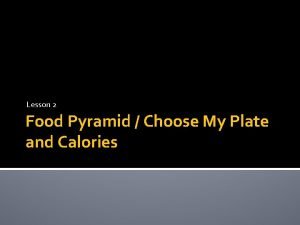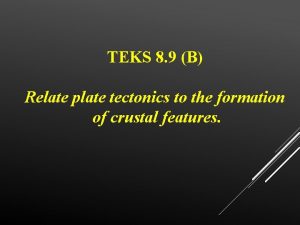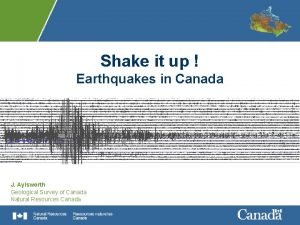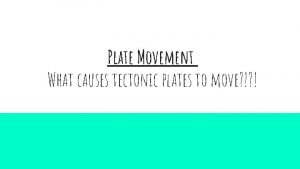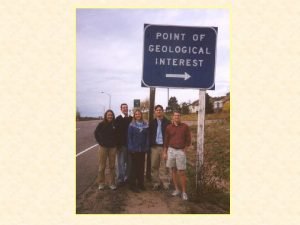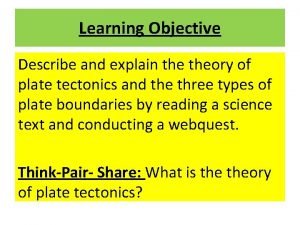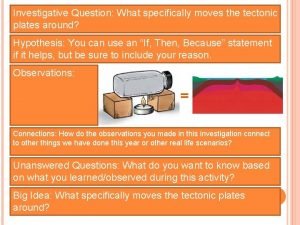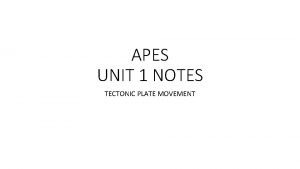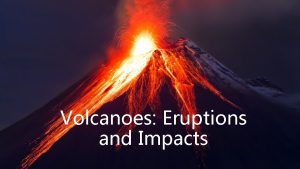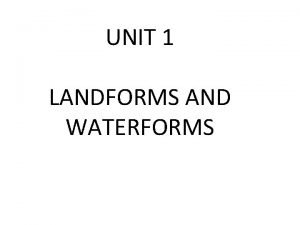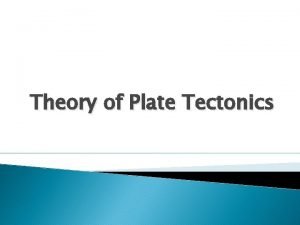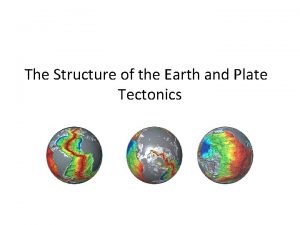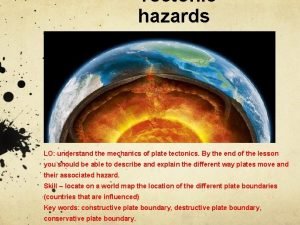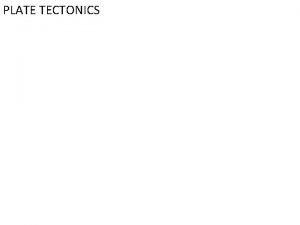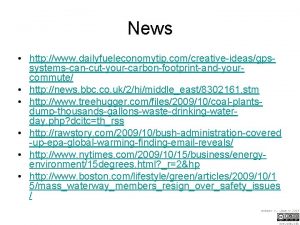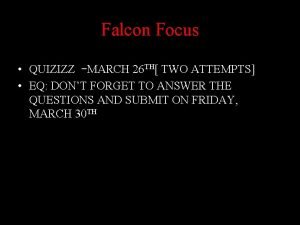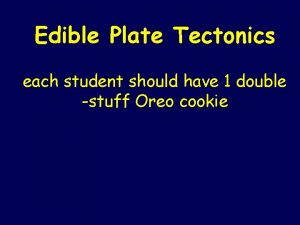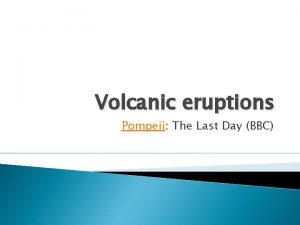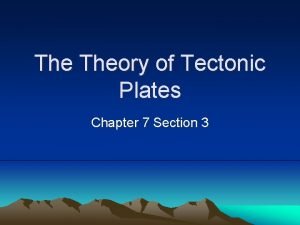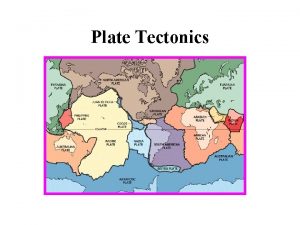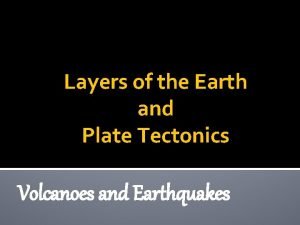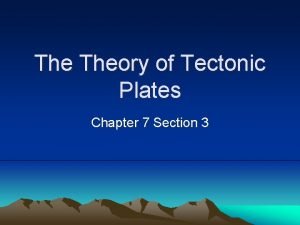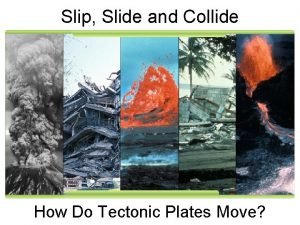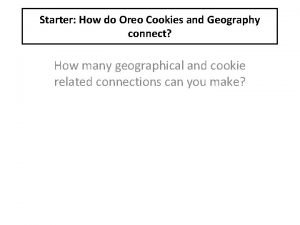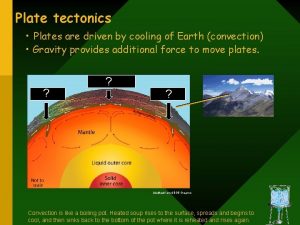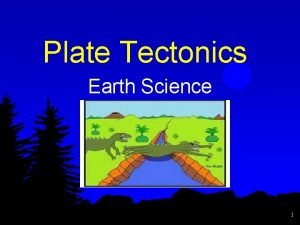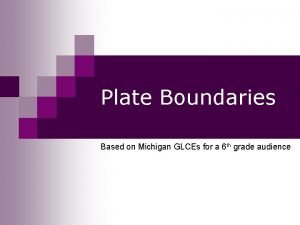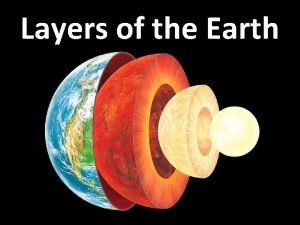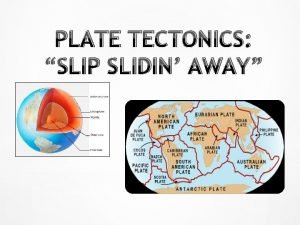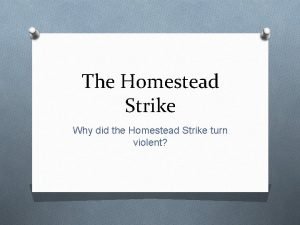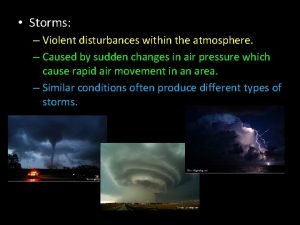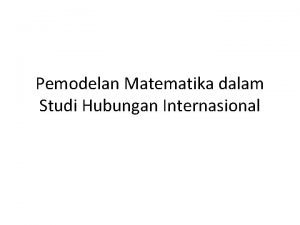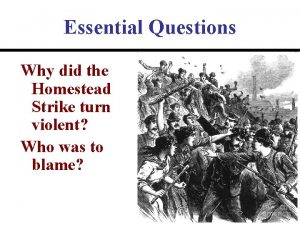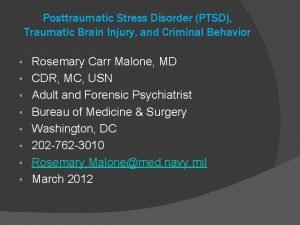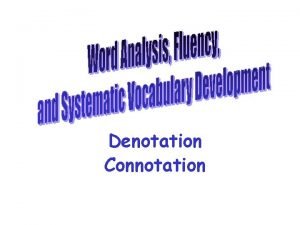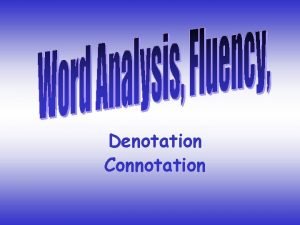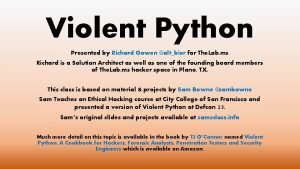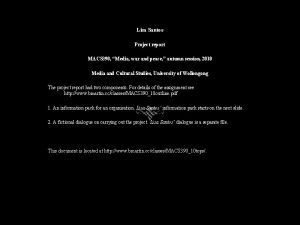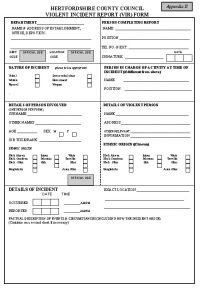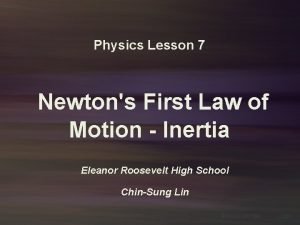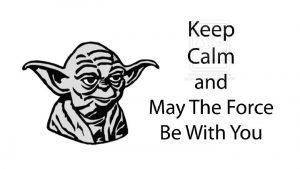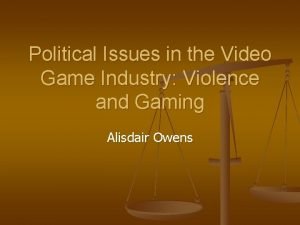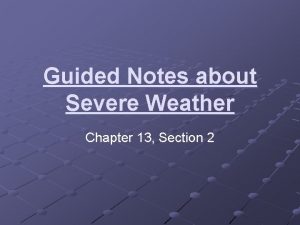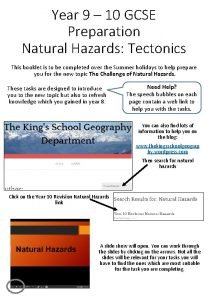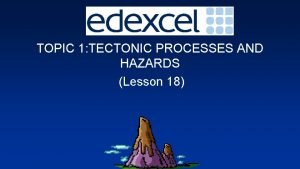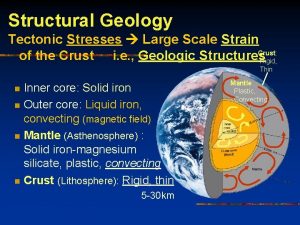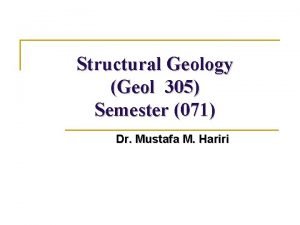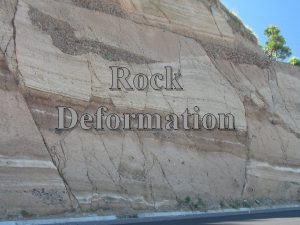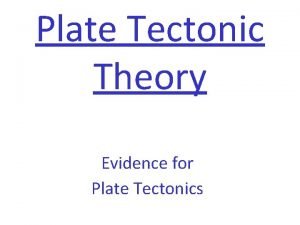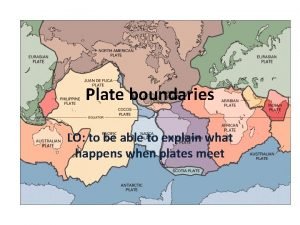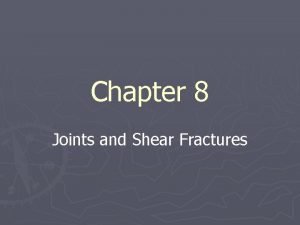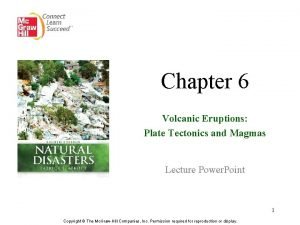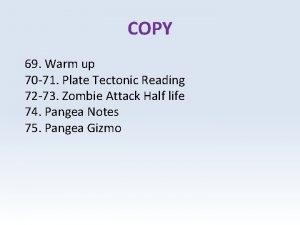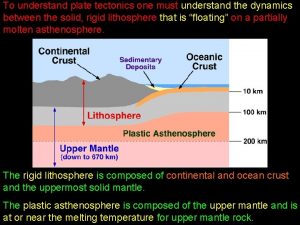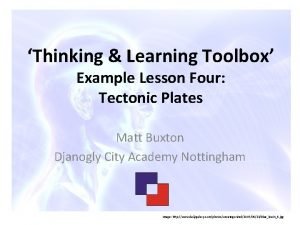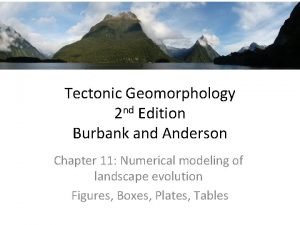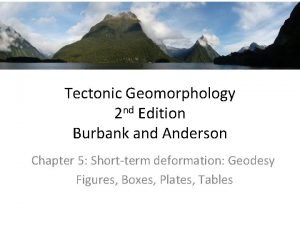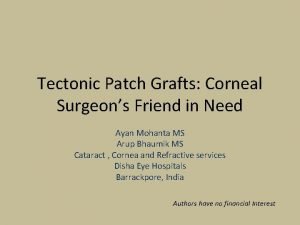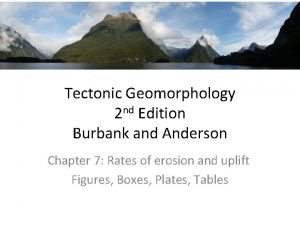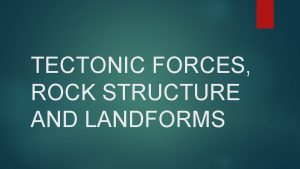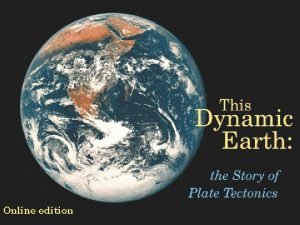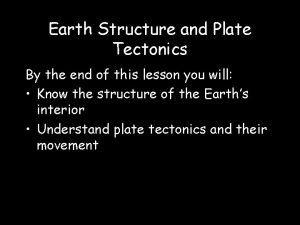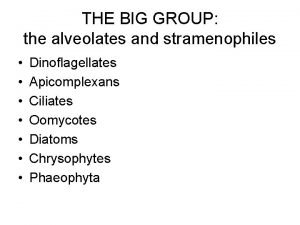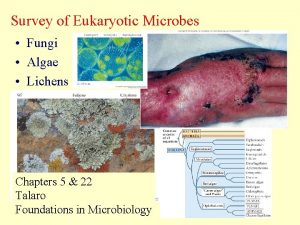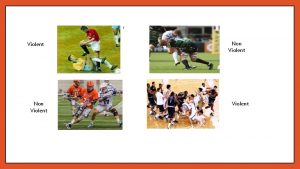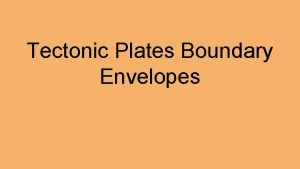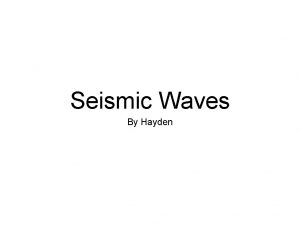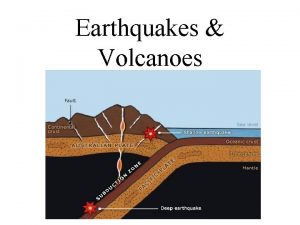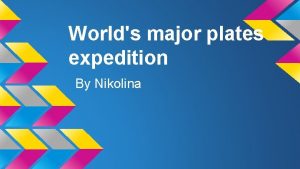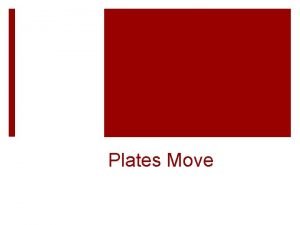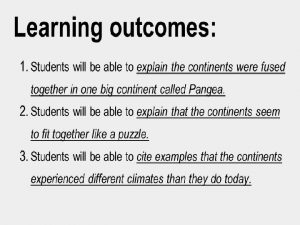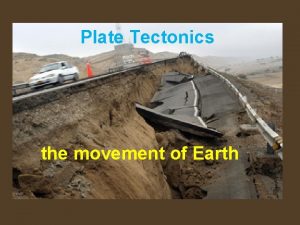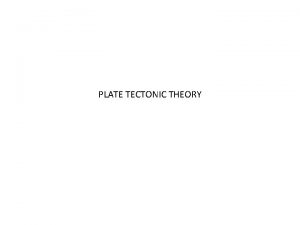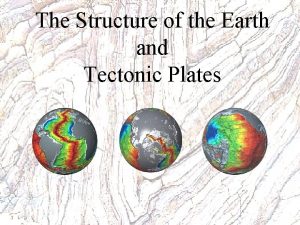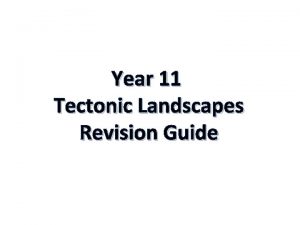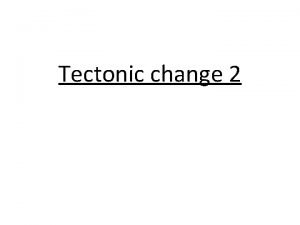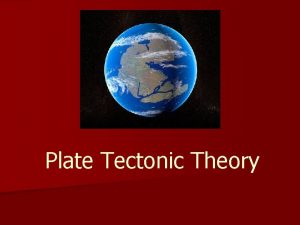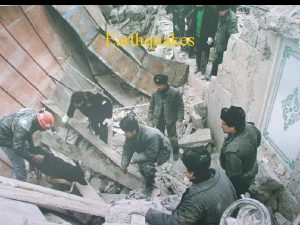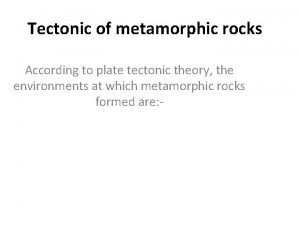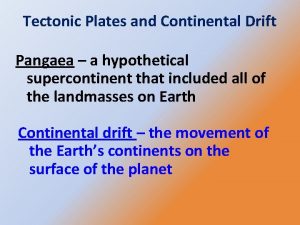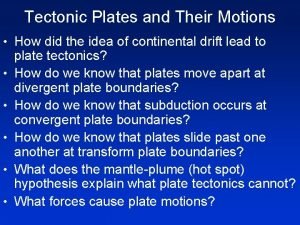The Tectonic Plates The Violent Earth Types of



















































































- Slides: 83

The Tectonic Plates The Violent Earth


Types of Crust • Continental Crust – 20 to 70 km (10 to 30 miles) thick. • Oceanic Crust – 7 km (4 miles) thick.

Thick, Buoyant (Felsic) Continental Crust Thin, Dense (Mafic) Oceanic Crust

Density For comparison, the density of water = 1. 0 g/cc 3. 0 g/cc 2. 6 g/cc 4. 3 g/cc 5. 7 g/cc

Isostasy (Compare to an iceberg rising out of the ocean)

Isostasy Cherry: 0. 4 g/cc Mahogany: 0. 7 g/cc Less dense rides higher Denser rides lower Water: 1. 0 g/cc

Oceanic crust is mafic Basalt Continental crust is felsic Granite

Thick, Buoyant Continental Crust Floats Higher Thin, Dense Oceanic Crust Floats Lower

The Tectonic Plates

Plate Tectonics: Why do we care? • In order to understand natural hazards, we must first understand the driving forces behind plate tectonics.

What is plate tectonics? • Explains how the top ~100 km of the Earth evolves • Describes deformation and movement within the Earth’s outermost layers • The “Grand Unifying Theory” of earth sciences • Developed since the 1960 s-1970 s

Lithosphere • • • Includes the crust and the upper mantle ~100 -150 km thick on average Rigid, solid, hard…. Composes the tectonic plates Lithosphere “floats” on the semi-solid, gooey asthenosphere (the asthenosphere is the hot upper mantle)

The crust is like a cracked egg shell

Plate Tectonics: Why do we care? • In order to understand natural hazards, we must first understand the driving forces behind plate tectonics.

What is plate tectonics? • Explains how the top ~100 km of the Earth evolves • Describes deformation and movement within the Earth’s outermost layers • The “Grand Unifying Theory” of earth sciences • Developed since the 1960 s-1970 s

Lithosphere • • • Includes the crust and the upper mantle ~100 -150 km thick on average Rigid, solid, hard…. Composes the tectonic plates Lithosphere “floats” on the semi-solid, gooey asthenosphere (the asthenosphere is the hot upper mantle)

The crust is like a cracked egg shell

Plate Tectonics • Tectonics: From the Greek “tecton” which means “builder” or “architect” • The study of large features on Earth’s surface and the processes that formed them.

Plate Tectonics • Large features: – continents – ocean basins – mountain ranges • and processes: – earthquakes – volcanic eruptions • due to movement of plates of Earth’s outer shell.

The plates are moving!

Geology of Natural Disasters • To understand the geology of many natural disasters, you must understand rock types and processes: • along the boundaries of plates • divergent • convergent • transform


Three types of plate boundaries


The newest oceanic crust is forming now; the oldest oceanic crust is Jurassic (~180 Ma)

Young & Old Crust • Continental Crust - Up to 4 billion years old. • Ocean crust - Only up to 180 million years old. • Why is the ocean floor so young relative to the continents? — The answer is in plate tectonics

Sea Floor Spreading & Plate Tectonics • New ocean basins form from volcanism • Ocean floor forms IN BETWEEN pieces that have split • SEAFLOOR SPREADING

Divergent Plate Boundary


What is the most striking feature of the ocean floors?

Mid-Ocean Ridge System (Divergent plate boundaries)

MOR profile

Youngest crust is at the margin Crust gets older away from the margin

Cr ust F To orm da in y g Cr ust 18 F 0 o rm M Ye ars illio ed Ag n o

Magnetic field and stripes • Volcanic rocks (including those created at mid-ocean ridges) contain magnetic minerals • These minerals align with the Earth’s magnetic field • The rocks record the direction of the magnetic field at the time that they cooled (below ~580°C) • The magnetic field reverses through time (magnetic north becomes magnetic south, etc. )

Magnetic stripes at spreading centers Rocks record the Earth’s history of magnetic reversals on the sea floor



Mid-Atlantic Ridge in Iceland

CONTINENTAL RIFT ZONES

The Basin & Range Province a continental rift zone

Continental Rifts & Normal Faults Normal faults produce Basin & Range structure

East Afric Rifts an Continental Rift Zone

Red East Afric Rifts an Sea Continental Rift Zone New Ocean Basin

Red New Ocean Basin East Afric Rifts an Ri n ea Oc id- dge M Sea Continental Rift Zone Indian Ocean Advanced Ocean Basin

Continental Rifts

Continental Rifts


East African Rift Zone Twigambili Escarpment

East African Rift Zone Nukuru

Ethiopia

What happens to the new crust? • We now know that new crust is continually formed • Does the surface area of the Earth continually increase? • The Earth isn’t expanding, is it? No! • Then what happens?


Convergent Plate Boundary

Convergent Plate Boundary Usually one plate is “subducted” beneath the other. As the subducting plate goes deeper, it heats up and begins to melt. Molten rock is buoyant and rises Creates big, explosive volcanoes. Subduction can create very deep earthquakes (up to 600 km), intermediate earthquakes, and shallow earthquakes.



Earthquakes at convergent margins

Subduction Zones = Volcanoes! Kamchatka, Russia Philippines Mount St. Helens

Not all volcanism occurs along convergent margins, but most does. . .




Continent-continent collisions

Continent-continent collisions Himalaya Mountains • Broad, diffuse zones of shallow-intermediate depth earthquakes • Very high topography

EARTH = Giant Recycling Machine! • Divergent Plate Boundaries: – Plates created! • Convergent Plate Boundaries: – Plates destroyed!

Types of Plate Margins Transform


Transform Plate Boundary

Transform Plate Boundaries • Crust is neither created nor destroyed • Plates scrape past each other • Plate boundary (the San Andreas fault) runs through most of California, in our own backyard

The San Andreas fault — our very own transform plate boundary Point Reyes Pinnacles

San Andreas fault Only shallow earthquakes along transform boundaries, but they can be BIG earthquakes

Transform Plate Boundaries = Earthquakes!


Plate Tectonic development of the Pacific/North America plate boundary



Transform faults between segments of mid-ocean ridges These are called ‘fracture zones’

What drives plate tectonics? Internal energy of the earth!

Pangea


Evidence for Continental Drift
 Choose my plat.gov
Choose my plat.gov Character traits for romeo
Character traits for romeo These violent delights have violent ends shakespeare
These violent delights have violent ends shakespeare Divergent boundaries
Divergent boundaries Mariana trench
Mariana trench Tectonic plates canada
Tectonic plates canada Tectonic movement
Tectonic movement V
V Romanche trench
Romanche trench What is the border between two tectonic plates called
What is the border between two tectonic plates called Tectonic plates with names
Tectonic plates with names Example of an investigative question
Example of an investigative question Plate tectonics definition apes
Plate tectonics definition apes Shield volcano
Shield volcano Convection cells
Convection cells Tectonic plates interact at places called plate
Tectonic plates interact at places called plate Struture of the earth
Struture of the earth Tectonic plates move
Tectonic plates move A plate
A plate How many major tectonic plates
How many major tectonic plates Parts of an earthquake
Parts of an earthquake Divergent boundary oreo
Divergent boundary oreo Pompeii tectonic plates
Pompeii tectonic plates What causes tectonic plates to move? *
What causes tectonic plates to move? * Fun facts about tectonic plates
Fun facts about tectonic plates Egg tectonic plates
Egg tectonic plates Oceanic oceanic convergent boundaries
Oceanic oceanic convergent boundaries Two regions of the mantle
Two regions of the mantle 7 tectonic plates
7 tectonic plates Slip slide and collide
Slip slide and collide Oreo cookies and plate tectonics answer key
Oreo cookies and plate tectonics answer key Tectonic plates meaning
Tectonic plates meaning Plate tectonics
Plate tectonics Is michigan on a tectonic plate boundary
Is michigan on a tectonic plate boundary What are the 3 layers of the earth
What are the 3 layers of the earth Different plate boundaries
Different plate boundaries Setting of things fall apart
Setting of things fall apart Definition of homestead strike
Definition of homestead strike Violent disturbance in the atmosphere
Violent disturbance in the atmosphere Menurut model dulluth, dasar dari relasi yang non-violent
Menurut model dulluth, dasar dari relasi yang non-violent Nvc cheat sheet
Nvc cheat sheet Why did the homestead strike turn violent?
Why did the homestead strike turn violent? If a resident with ad shows violent behavior the na should
If a resident with ad shows violent behavior the na should Ptsd violent behavior
Ptsd violent behavior Gun control thesis statement
Gun control thesis statement English 9 vocabulary unit 1
English 9 vocabulary unit 1 Violent vs nonviolent restraints
Violent vs nonviolent restraints Non violent crisis intervention techniques
Non violent crisis intervention techniques Commitment denotation
Commitment denotation Brutal connotation
Brutal connotation Violent python 3
Violent python 3 Violent video games
Violent video games Violent incident report form
Violent incident report form Newton's first law roller coaster
Newton's first law roller coaster Violent one hour
Violent one hour Violent motion
Violent motion Do violent games cause violence
Do violent games cause violence Violent downdrafts that are concentrated in a local area
Violent downdrafts that are concentrated in a local area Primary and secondary effects of a tectonic hazard
Primary and secondary effects of a tectonic hazard Primary volcanic hazards
Primary volcanic hazards Tectonic hazard profile
Tectonic hazard profile Compare continental drift and plate tectonics
Compare continental drift and plate tectonics Plunging anticline
Plunging anticline Tectonic joints
Tectonic joints Fold
Fold Plate tectonic theory
Plate tectonic theory Continental drift theory and plate tectonics theory
Continental drift theory and plate tectonics theory Collision plate boundaries
Collision plate boundaries Joints geology
Joints geology Three v's of volcanology
Three v's of volcanology Building pangea gizmo map
Building pangea gizmo map S waves
S waves Tectonic
Tectonic Tectonic
Tectonic Tectonic
Tectonic Tectonic graft cornea
Tectonic graft cornea Tectonic
Tectonic Tectonic
Tectonic What tectonic plate is south africa part of
What tectonic plate is south africa part of Convergent plates
Convergent plates Plate boundary
Plate boundary Tectonic
Tectonic Oomycotes
Oomycotes Aseptate
Aseptate
